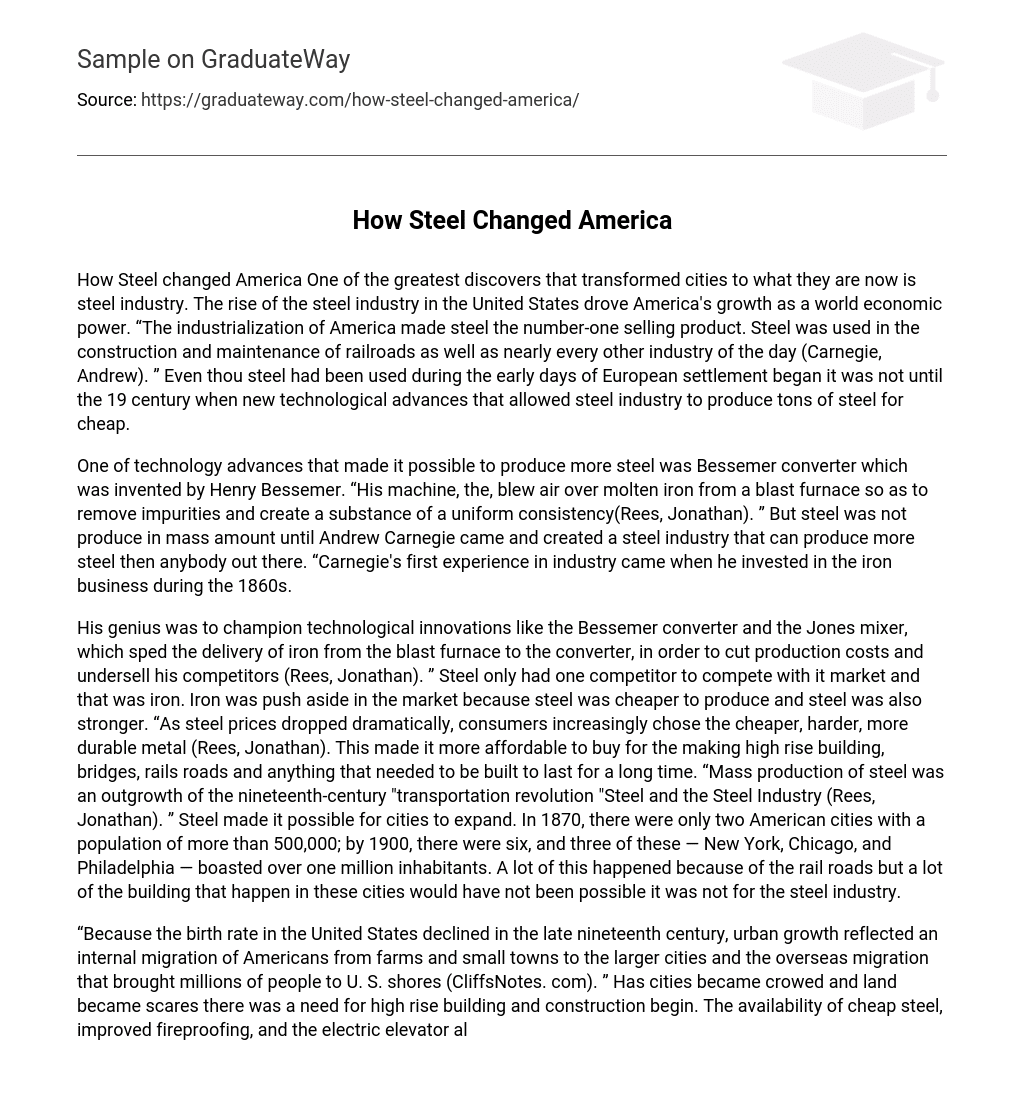The steel industry was crucial in the development of contemporary American cities, according to Andrew Carnegie. Its expansion propelled the United States into a dominant global economic force. Steel became highly sought after as a result of America’s industrialization, finding application in nearly every industry during that era. Though steel had been utilized since European colonization, it wasn’t until the 19th century and advancements in technology that substantial quantities of affordable steel could be manufactured.
The Bessemer converter, created by Henry Bessemer, was a significant technological advancement in the steel production growth. Jonathan Rees clarifies that this device utilized air to eliminate impurities and achieve a consistent and uniform substance. However, it was only through Andrew Carnegie’s involvement in the industry and his establishment of a steel empire that mass production of steel became possible. During the 1860s, Carnegie made his initial foray into the industry by investing in the iron business.
Jonathan Rees discusses the cleverness of promoting technological advancements in the steel industry, highlighting two specific innovations: the Bessemer converter and Jones mixer. These advancements aimed to expedite iron transportation from blast furnace to converter, reducing production costs and outperforming competitors. Consequently, steel emerged as a dominant force over iron due to its lower production costs and superior strength. This preference shift had significant implications for construction projects like high-rise buildings, bridges, and railroad tracks.
The rapid growth of the steel industry was directly tied to the “transportation revolution” of the nineteenth century and played a crucial role in fueling urban expansion. Prior to 1870, only two American cities had populations exceeding 500,000; however, by 1900 that number increased to six cities with over one million inhabitants including New York City Chicago Philadelphia among others. While railroads were major contributors to this period of growth in history, we must not underestimate the impact made by the steel industry (Rees).
The growth of cities in the late 19th century in the US can be attributed to multiple factors. Firstly, a decrease in the birth rate prompted Americans to relocate from rural areas and small towns to larger urban centers. Furthermore, millions of immigrants arrived in the US during this period, adding to the population influx. Consequently, cities became overcrowded and land became scarce, leading to the construction of tall buildings. This was facilitated by the availability of affordable steel, advancements in fireproofing techniques, and electric elevators. The expansion of the steel industry also created numerous job opportunities for individuals with agricultural backgrounds. Additionally, industrialization during this time led to a shift towards city living and factory labor as thousands were employed in industrial jobs. Immigrants particularly found employment prospects through industrialization and were encouraged to settle in cities for work.
The majority of the “American City” population lived in slums due to poorly paid jobs in the steel industry (David Gardiner). The steel industry played a significant role in America’s growth as a global powerhouse by maximizing profits through low wages. Although these practices might be considered unethical or illegal today, there were no employee protection laws at that time. As a result, the steel industry could maintain low prices and support large-scale construction projects like monumental bridges and groundbreaking buildings.
The rise in construction led to a significant influx of people relocating to urban areas due to the abundance of job prospects, thereby fostering the growth of contemporary cities across the United States and establishing the professional occupations prevalent today. By the late 1800s, America had emerged as the global frontrunner in industrialization, largely attributable to its extensive steel manufacturing capabilities. Consequently, not only did the steel industry play a crucial part in reshaping the national economy but it also underwent its own metamorphosis.
The technological and organizational changes in the American steel industry during the nineteenth century were both causes and effects of an increasingly diverse, rapidly urbanizing industrial society (Carnegie, Andrew).” “Gilded Age and Progressive Era Reference Library. Ed. Lawrence W. Baker and Rebecca Valentine. Vol. 3: Primary Source. Detroit: UXL, 2007. 51-59.”. Retrieved from “http://www.CliffsNotes.com/study_guide/tml/topicarticleid-25238,articleid-25184”.
David Gardiner (2011) discusses The Rise of the America City. Retrieved from “http://apnotebook2007.pbworks.com/w/page/35209082/The%20Rise%20of%20the%20America%20City”.
Jonathan Rees provides information on the Iron and Steel Industry in the Dictionary of American History. Retrieved from “http://links.galegroup.com/apps/doc/CX3401802662/UHIC?sid=summon&xid=e9ce674a”.
The Encyclopedia of the United States in the Nineteenth Century also contains information on Steel and the Steel Industry, Retrieved from “http://links.galegroup.com/apps/doc/CX3401803057/UHIC?sid=summon&xid=b92d1c59”.





